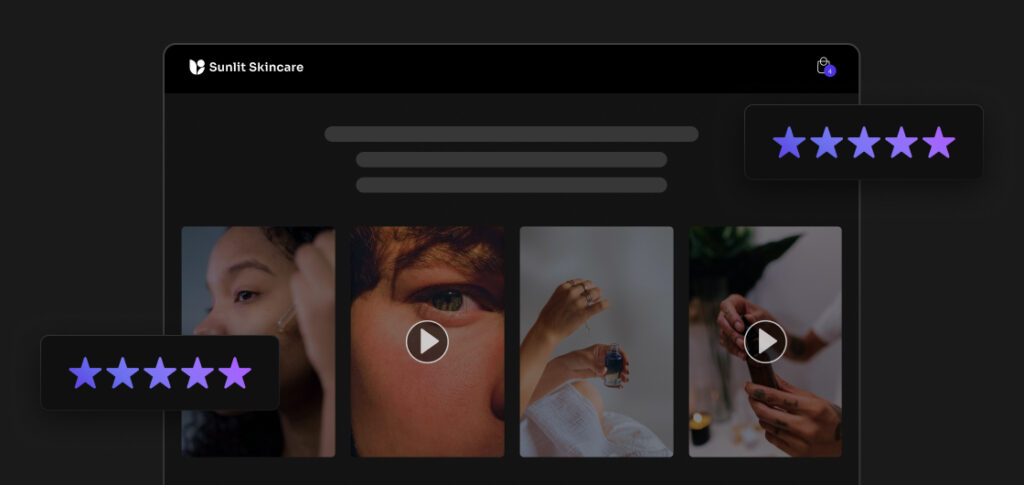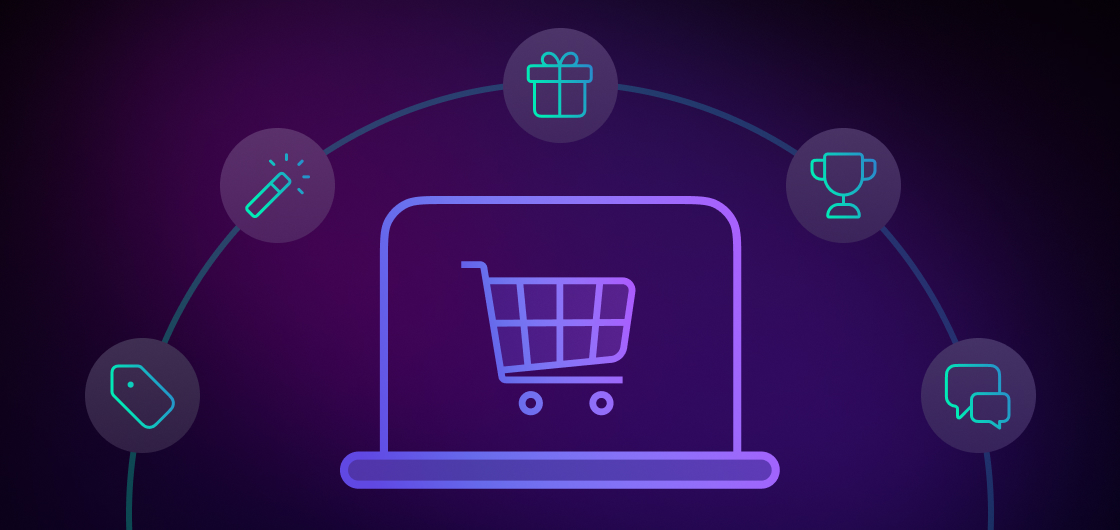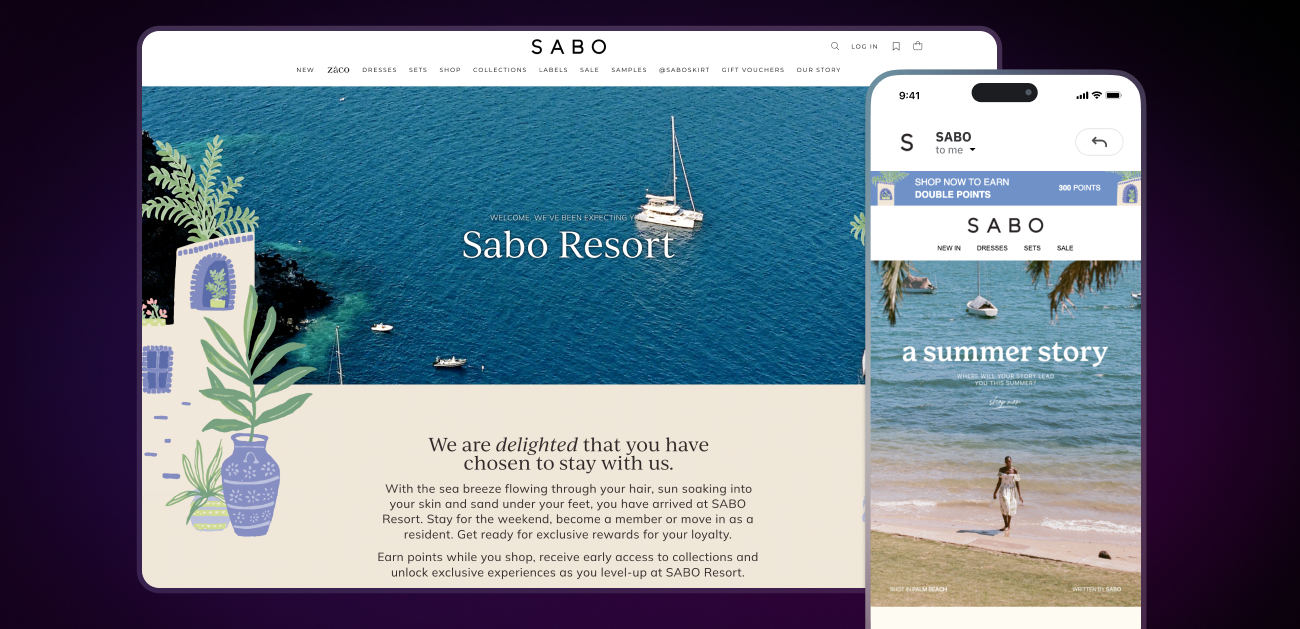
- Customer Marketing
- Reviews and UGC
- Social Proof
How To Add Social Proof on Shopify
Katie Vaught | Apr 25, 2025
Dec 2, 2024 | 17 minute read

Matt Goodman
Co-founder, CEO
DTC ecommerce is set for significant changes in 2025, driven by AI and the need to build stronger customer relationships. As consumer expectations rapidly evolve, brands must adapt to thrive. To stay ahead, it’s crucial to understand upcoming trends. We consulted fast-growing brands and ecommerce experts to uncover the key customer marketing trends for 2025. Here’s what they said.
The future of DTC ecommerce is set to take flight in 2025. Are you ready for it?
From AI-driven shopping experiences that feel tailor-made for every customer to brands doubling down on customer relationships for ultimate loyalty, the game is changing fast.
With consumer expectations evolving at an unprecedented pace, meeting them will be crucial for brands aiming to thrive in this dynamic landscape.
Stay ahead in this fast-evolving space by knowing the ecommerce trends for 2025. The time to innovate is now.
To help, we asked fast-growing brands and experts in ecommerce what they think are the biggest customer marketing trends for 2025. Here’s what they said.
Loyal customers are the backbone of any lasting brand success. When you focus on retention, you create loyal customers who keep returning. How do you do it? By creating engaging loyalty programs.
These dynamic programs increase customer engagement and inspire repeat purchases by rewarding shoppers for their interactions. In fact, according to loyalty program research by Okendo, 77% of customers say they are more likely to be loyal to a brand long-term if the brand offers a loyalty program.
Loyalty programs don’t just turn occasional shoppers into loyal customers—they create Superfans who are highly engaged, genuinely love your store, and choose it time and time again. With a personalized, VIP tiered structure, a loyalty program keeps customers engaged and gives them another reason to pick you over the competition.

Anna Metcalfe, Head of Marketing and Growth at Kat the Label, says her team has a sharp focus on retention in 2025 through the power of loyalty programs.
“We’re focusing largely on retention at Kat the Label to drive a higher lifetime value and build lifelong fans. We are looking to expand our product range to meet our customers in many areas of their wardrobe — lingerie, sleepwear, swimwear, and lounge.”

Metcalfe says that with customer acquisition costs rising, her team is finding it even more important to retain customers.
“We have recently revamped our loyalty program which has seen a strong uptake in our Australian market, and something we are focusing on in our U.S. market for 2025. As we work on more design collaborations and branded moments throughout the year, we look to reward loyalty members with early access, exclusive products, and promotions,” she says.
Metcalfe’s additional advice to brands for 2025: “Always keep your customer experience front of mind in everything you are doing – from design to marketing campaigns to in-store experiences and branded activations.”

Adrian Muscat, Senior Performance Lead at SABO, agrees that loyalty helps combat high acquisition costs.
“Cost per thousand impressions will never decrease or normalize. It feels like a never-ending battle to outperform the rise in ad costs. Loyalty helps attack the problem head-on by extracting revenue from easier avenues, while we fight to find more efficient ways to acquire customers.”

As for why Muscat sees loyalty as a key 2025 trend, he says it’s because SABO’s customers who are members of the brand’s loyalty program are 3.1x more likely to make a repeat purchase.
Muscat’s additional advice to brands for 2025: “Focus on the second purchase.”

Sukh Sidhu, VP of Partnerships at Ordergroove, agrees that retention is a focus for 2025. He has a bold strategy to tackle it: focus on elevated subscriptions.
Sidhu says, “As customer acquisition costs reach untenable levels for many merchants, we see a trend in customer marketing of reprioritizing away from merely acquiring new customers, to retaining them for the long term to drive customer lifetime value.”
“Most brands that launch subscriptions will see an immediate 2-4x lift (or more) on their subscription-based customers vs. customers who buy transactionally. This allows brands to generate huge revenue growth driven purely by increases in customer LTV with their existing customers rather than needing to acquire new customers.”
Sidhu says that subscriptions that go beyond the basics of ‘subscribe and save’ can increase retention.
“As a result, we’ll see more brands continue to enable subscriptions, while those offering subscriptions will double down with better experiences to increase repeat purchase rates. Elevated offerings like build-your-own boxes, specially designed discounts that increase over time, curated rotating boxes, memberships, and more can drive exponentially higher CLTVs than a simple subscribe & save offer,” Sidhu says.
As for creating and leveraging Superfans, Sidhu highlights that the more seamless and engaging subscription experiences can turn transactions into positive experiences that strengthen the consumer and brand relationship.
“Often, the top 1% of shoppers will spend 10x or more than the average shopper – these people have a disproportionate impact on your business and are your Superfans,” Sidhu says.
“To encourage these Superfans, you should design special experiences to engage them in new ways to build deeper relationships, which will drive even more delight, spend, retention, and higher CLTVs with them.”

While Karlie Vanderpluym, Solution Consultant at Convert Digital predicts AI-driven personalization is a trend, she also notes retention and loyalty as a main focus for 2025.
Her advice to brands in 2025 is to prioritize building authentic relationships with customers by focusing on transparency and community engagement. As consumers increasingly seek personalized experiences, leveraging data to refine strategies and enhance customer interactions will help you stay competitive in 2025.
She says, “As customers increasingly demand tailored experiences, the ability to deliver hyper-personalized recommendations, product offerings, and content in real-time will set brands apart.”
Brands can capitalize on AI-driven personalization by creating interactive experiences that invite customers to share their preferences. According to Vanderpluym, there’s a growing trend of consumers craving offline connections—like Coach’s popular pop-up events.
To stay ahead, investing in AI tools that provide personalized recommendations is no longer optional — it’s essential.
Speaking of retention, our experts predict that boosting customer lifetime value will be a main focus in 2025.

Gabrielle Noakes, Ecommerce Manager at Dixxon Flannel Co., says her team is aiming to increase customer lifetime value now and into 2025.
“With such a wide range of products and product collaborations, it’s important to comprehend why a customer chose to continue or terminate their relationship with us after completing their first purchase.”
Noakes highlights that in a time of rising prices and an increased cost of living, consumers are rightfully choosing to be more conscious of where they spend their hard-earned dollars. “If your brand does not feel authentic — if the shopping experience does not feel customized to them — customers will move on to a different brand that appears to care more about them than the bottom dollar.”
As far as success in customer marketing, Noakes says that with advancements in AI, hyper-personalization and user-generated content have both skyrocketed in the last year. These improve the customer experience and also provide social proof and increased engagement.
“I can only see these going up as long brands are responsible with the information they gather and evolve to focus on the betterment of factors such as accessibility and data privacy.”
The customer experience is a consistent focus in ecommerce, with 43% of customers saying they have switched brands due to a negative experience, according to retention and loyalty research by Okendo. The shift into 2025 will be placing even more focus on personalizing the experience.

Caela Castillo, Director of Customer Experience at JAXXON, says, “While AI and automation have been a focus for us over the last year, we believe the overall customer experience is significant in driving retention and LTV.”
“We’ve seen brand-focused marketing work really well. This will continue to evolve in 2025 because customers want to feel part of a brand community,” she says.
Castillo emphasizes how important it is to be able to use qualitative and quantitative data to tell the full story of your brand.

On the same theme of customer experience, Kyle Panganiban, Partner Enablement Manager at Rebuy, says personalization throughout the customer journey is the biggest way for brands to get ahead in 2025.
Panganiban says, “As the ecommerce landscape gets more and more competitive, personalization will help brands set themselves apart from the competition and gain shoppers’ loyalty. 71% of consumers now expect brands to deliver personalized experiences and 78% of consumers are more likely to make repeat purchases from brands that personalize the shopping experience.
He recommends that brands implement personalized product recommendations and offers throughout the on-site customer journey. This includes the homepage, product pages, and during the checkout process. Some examples of personalized offers include a free gift with purchase incentives, buy more save more discount offers, discounted product bundles, and checkout upsells.
When it comes to creating Superfans, Panganiban notes personalization isn’t just a buzzword—it’s how you connect with your shoppers on a deeper level, especially the loyal ones who keep coming back. By implementing a flexible and powerful personalization solution, you can deliver hyper-specific recommendations and offers that perfectly match your customers’ tastes.
As for further advice to brands for success in 2025: “Integrating your tech stack with personalization solutions can help to create a tailored, omnichannel customer experience that keeps customers coming back. Consider implementing personalized product recommendations in email, SMS, tracking pages, and mobile apps to improve customer retention.”
Hyper-personalization is revolutionizing customer experiences like never before. With AI at its core, it’s all about creating unique, tailored interactions that leave customers feeling truly seen and understood. It’s not just personalization—it’s building stronger connections and showing your customers that your brand gets them.

Milla Truscott, Digital Strategist at Arkhi, says the main trend of 2025 comes down to hyper-personalization driven by AI & zero-party data, adding that there’s a bigger focus on retention and increasing lifetime value (LTV) through loyalty programs and enhanced customer experiences.
The reasoning for this focus in 2025 is that it will assist in creating tailored experiences to capture user attention and deepen engagement in an increasingly saturated market. Additionally, rising acquisition costs will push brands to focus on retention and increasing customer lifetime value (CLTV) through loyalty programs and enhanced customer experiences.
She recommends leveraging AI across advertising channels, so brands can deliver highly tailored marketing messages and product recommendations that resonate with individual customer preferences. Brands should also be looking to implement targeted loyalty programs to further strengthen these relationships, fostering deeper engagement and encouraging repeat purchases.
“Hyper-personalization and a focus on customer lifetime value help brands cultivate Superfans by creating tailored experiences that deepen emotional connections and engagement. As these customers feel recognized and valued, they become advocates for the brand, leveraging their social influence to attract new customers and drive growth.”

Erin DeCesaris, Ecommerce Growth Strategist at Fuel Made, agrees that AI and hyper-personalization will be a focus in 2025. DeCesaris also comments that specific technology like improved chatbots and predictive data will allow brands to better target customers with personalized marketing.
“As AI becomes more commonplace and continues to gain user trust, [customers] will expect to see more of it in their shopping experiences,” DeCesaris said.
DeCesaris recommends brands understand how their tech partners incorporate AI into their tools, and to talk to them about how they can take advantage of that in the brand’s store.
“You don’t have to build this from scratch – you just have to be proactive with taking advantage of how AI can be used across existing touch points and marketing tools.”
“Using AI to create hyper-personalized shopping experiences will allow you to turn more customers into Superfans and leverage existing Superfans by making it easier for them to share their experiences with their network.”
DeCesaris offers this further advice to brands: Customer expectations are higher than ever, so continue to evaluate your shopping experience (including pre-and post-purchase touch points) to make sure it’s as seamless as possible. Beyond an easy-to-use website (table stakes), offer competitive pricing, shipping and service policies, and ensure you’re continuously adjusting your policies to meet customer expectations and needs.

Joe Fazzalari, Technology Partnership Manager at Gorgias, also sees AI-powered personalization as the biggest customer marketing trend for 2025.
“Brands will increasingly use AI to create highly customized, real-time interactions that enhance the customer journey, from pre-purchase to post-purchase engagement.”
“This focus on personalization will help brands improve customer satisfaction and loyalty, especially in an increasingly competitive market.”
To capitalize on this trend, Fazzalari says brands can leverage AI to automate customer support tasks, like answering common queries, providing order updates, and personalizing product recommendations. Additionally, implementing AI-driven post-purchase workflows can keep customers engaged and encourage repeat business through follow-up communications and tailored content.

Daniela Rouse, Head of Ecosystem Marketing at Triple Whale, is also a believer that hyper-personalization through AI-driven insights is the future of customer marketing.
She says the reason why is that consumers expect unique experiences that resonate with them. Whether that’s personalized product recommendations, dynamic pricing, or messaging that shifts in response to customer interactions across channels.
“Brands can make the most of this trend by investing in AI-powered tools that analyze real-time customer data to create personalized, seamless experiences across all touchpoints. Additionally, focusing on building a robust zero-party data strategy will allow brands to continuously refine and enhance customer interactions, driving loyalty and long-term growth,” she recommends.
She notes that making customers feel uniquely understood and valued will help create and leverage Superfans. By consistently offering relevant and timely interactions, brands can build deeper emotional connections, fostering loyalty and advocacy.
She offers this further advice to brands for success in 2025: “Brands should prioritize agility, using real-time insights to quickly adapt to changing customer behaviors and market conditions. Embracing a customer-centric approach with personalized, data-driven experiences will be key to standing out and building long-lasting customer relationships.”

Rally Stanoeva, Manager, Product Marketing – Emerging Products at Postscript also says AI helps marketers unlock entirely new personalization capabilities and have more meaningful conversations with their customers in 2025.
Stanoeva says, “First, economic conditions are stabilizing, allowing brands to allocate some budget towards AI technology. And second, Large Language Models (LLMs) are improving how structured and unstructured data—such as customer conversations, reviews, social media interactions, and dynamic site content—are processed, understood, and leveraged into high-value actions. This capability is transforming key aspects of marketing, including how we can communicate with customers in a deeply personalized way.”
Stanoeva’s advice: Investigate marketing technologies that allow you to gather customer data well beyond the same click and impression data that every other brand is also using.
“Connection is still what all consumers want. In a world where you can buy a black puffy coat at virtually thousands of websites, what customers want is a reason to connect with a certain brand. They want to know a brand they’re supporting understands their needs and sees them as more than just another number.”

Omnimodal shopping for ecommerce represents a significant advancement in how consumers engage with brands. Rather than focusing on transactions across channels, omnimodal shopping focuses on personalized shopping journeys. This approach emphasizes the need for brands to create a consistent and unified experience across all digital touchpoints.
By utilizing zero-party data, brands can tailor their offerings to meet the unique needs of each shopper where they prefer to shop. Key components of omnimodal ecommerce include offering real-time inventory updates, creating personalized recommendations, and ensuring that customer service is accessible across all platforms.
Sarah Gallagher, CEO of Gamma Waves, says omnimodal shopping is a key trend for 2025.
“Brands will focus on omnimodal shopping in 2025 because it’s a continuation and evolution of the work done so far to create personalized, seamless shopping experiences — now they’ll work to adapt in real-time to consumers’ contexts, preferences, and emotional states.”
Gallagher also said that the shift is driven by advances in AI, the increasing integration of commerce into all aspects of digital life, and the rising expectations of younger consumers who demand frictionless, highly relevant interactions across all touchpoints.
“To capitalize on the omnimodal shopping trend, brands should focus on creating AI-driven, context-aware systems that can seamlessly adapt offerings, interfaces, and communication across all touchpoints in real-time. Brands should prioritize creating intuitive experiences that blend physical, digital, and virtual interactions, while ethically using data to anticipate and meet customers’ immediate needs,” Gallagher says.
When it comes to Superfans, Omnimodal shopping helps brands by offering hyper-personalized experiences that deepen brand loyalty. By adapting to Superfans’ preferences in real-time, brands can offer exclusive experiences that make these customers feel valued, encouraging active engagement with the brand and community.
Looking toward 2025, DTC ecommerce brands are ready to explore exciting opportunities for growth and innovation. Key trends like omnimodal shopping, AI-powered personalization, and a strong focus on customer retention with loyalty programs and engaging strategies are reshaping the landscape and setting the stage for transformative change.
Omnimodal shopping eliminates the divide between digital and physical retail, offering consumers a seamless and integrated experience across all channels. Meanwhile, advancements in AI are enabling businesses to deliver highly personalized shopping experiences, tailoring recommendations and interactions to individual preferences in meaningful ways.
For Shopify brands who are ready to adapt and innovate, 2025 offers a unique opportunity to not just keep pace but lead with customer-focused solutions and cutting-edge strategies. The future of ecommerce is here—are you prepared to make the most of it?
Related articles
Ready to learn more?